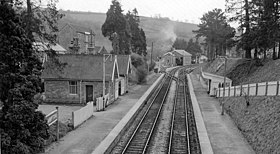Bampton (Devon) railway station
| Exe Valley Railway | |
|---|---|

Bampton station
|
|
| Overview | |
| Status | Closed |
| Locale | Devon |
| Termini | Morebath Junction Stoke Canon |
| Operation | |
| Opened | 1 August 1884 |
| Closed | 7 October 1963 |
| Owner | Great Western Railway |
| Technical | |
| Line length | 19.16 miles (30.84 km) |
| Number of tracks | 1 |
| Track gauge | 4 ft 8 1⁄2 in (1,435 mm) |
The Exe Valley Railway was a branch line built by the Great Western Railway (GWR) in Devon, England, to link its Bristol to Exeter Line with its Devon and Somerset Railway (D&SR), thereby connecting Exeter with Dulverton (which is in Somerset). The line was in use from 1884 until 1964.
The first part of the line to be built was the Tiverton and North Devon Railway, which ran from the D&SR at Morebath Junction south to Tiverton. It opened on 1 August 1884. The Exe Valley Railway itself started from the Exeter main line at Stoke Canon and ran northwards to Tiverton. This opened on1 May 1885.
Services generally ran through from Dulverton to Exeter St Davids. Trains could not stop at Stoke Canon station as the junction was built south of the station which had been opened on the main line in 1852. This was rectified in 1894 when a new station was built to the south of the junction. As with Stoke Canon, trains could not call at Morebath as the station was on the wrong side of the junction, but in 1928 a station was opened at the junction.
In 1890, Mrs Towns was appointed signalwoman at Morebath Junction. She is the only recorded example of a signalwoman on any railway in Britain in the 19th century. In October 1913, the Railway Magazine reported that she was "very proud" of her job after 23 years service and hoped to continue indefinitely.
On 1 January 1948, the GWR was nationalised to become the Western Region of British Railways. Stoke Canon station closed in 1960 and passenger trains were withdrawn from the line from 7 October 1963, although goods trains continued to run to Thorverton until 4 May 1964.
...
Wikipedia
